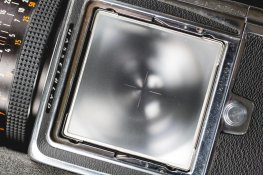You should be aware, as mentioned above, there are two types of Acute Matte screens. The original was brighter than the standard screens,but there were complaints it was harder to focus. They brought out the D variant, (both designed by Minolta) the one with two cut outs that look like a D, these were easier to focus (allegedly) but not just quite as bright. They also corrected, to some extent, the excessive vignetting of the first series.
It is not the case that a brighter screen is easier to focus. It is easier to see and compose the subject if in subdued light but the focus is dependant on contrast and a very bright screen, as in the first issue of Acute screens, coupled with photographers not being used to them, reduced contrast and made focusing harder, for some. This type of screen, because it does not diffuse the image as much as ground glass also has a higher degree of vignetting in the corners with longer lenses. The plane of the image is also less well defined in the Acute Matte screen type and that can lead to error.Be careful what you wish for.
You can of course "calibrate" your meter by adjusting the iso you set, you mention buying a metering prism calibrated to the screen. All PME3, 5, 45 and 90 are already so calibrated.
It does look like a 42165, as stated above and correctly on the cross types "etched" and painted, but also bear in mind it could be a third party screen by Beattie or Maxwell which also are unmarked. There was also a plain screen with cross and fresnel made in the Acute-Matte era for photomicrography work, due to the vignetting I alluded to earlier, the 42200.
If not an Acute Matte earlier screens with crosses were 42161, 4285 (1979 with a thinner cross), 42165 was 1989. Although obviously screens can be swopped the date of your camera may be of use in dating, your screen does not show marks of multiple holder clips. Just to be complete, though I doubt that, the D screen is 42204.
Never rely on a S/H box to identify BTW. People bought a new screen and placed the old one in the box, that then gets sold years later perhaps as the original "new" screen type!! Many people have bought D screens that were not that way.
This is not an example but there was for a very short time, and therefore for completest collectors collectible forcing them to be valued more highly, an optofiber/ optifibre screen. A slice of a bundle of optical glass fibres. It does not have a reference cross. It was prone to dark spots, like dead pixels, where a fibre had failed.
Finally!! You may find a "chimney" finder is better. This maintains a vertical angle of view on the screen, the optimum angle, with magnification and low light loss. I have never measured it but prism finders will rob you of some light just because of the optical path, if brightness is very important to you because of subject matter.
BTW this is all presented as personal opinion and not fact.















 )
)